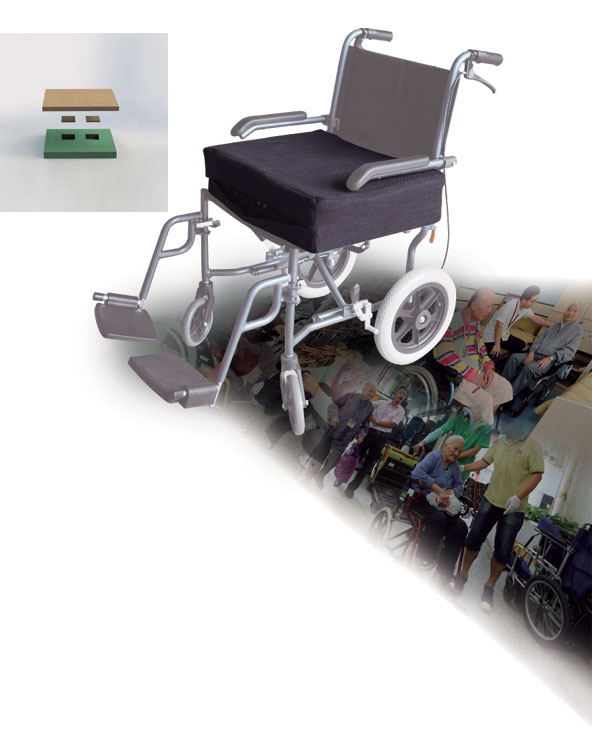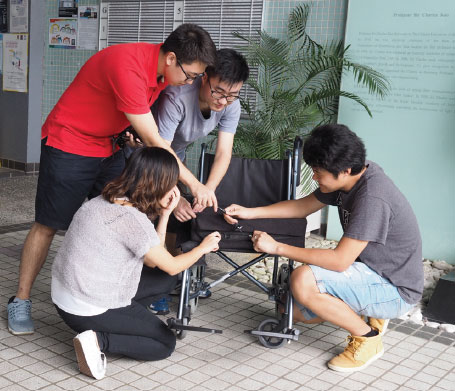Cushioning the blow with biotech
Updated: 2016-11-03 07:36
By Honey Tsang(HK Edition)
|
|||||||||
A 'smart' cushion developed by a bunch of young biomedical professionals from HK can help patients shift body weight from side to side to reduce chances of getting sores from sitting or lying in the same position for long. Honey Tsang reports.
newly developed cushion promises to bring pain relief for wheelchair-bound patients afflicted by pressure sores. Its creators call it a "smart" cushion, since it actually measures the pressure that causes the sores and then makes adjustments to reduce the pressure to prevent wounds from developing.
Yao Yifei, a recent PhD graduate in biomedical engineering at Chinese University of Hong Kong (CUHK), was the originator of the cutting-edge cushion. In November 2015, Yao and his team developed VibroSAC, a device designed to reduce pressure ulcers in patients confined to wheelchairs or beds. Most are elderly people and prone to chronic bedsores that can tear down a person's quality of life.
The sores flare up when a patient's skin and the underlying tissue are exposed to sustained stress that cuts off blood circulation. It can come from staying in bed or in a wheelchair over a prolonged period. The lesions can spread across the flesh and cut right to the bone, creating potentially fatal conditions if complications develop.

Li Pui-on, a registered wound care nurse at Union Hospital, said that some infirm elderly people are enfeebled to the point they haven't the strength to shift their weight to relieve the pressure that causes the pain.
"The worst case I've encountered so far is a patient who had bedsores around the sacrum (an area at the base of the spine)," Li said. "That wound blackened, and ulcerated, so that every second day the ulceration grew by 3 centimeters." With a large skin lesion spreading into the underlying tissue in a flash, Li recalled, the patient was teetering on the brink of a serious infection.
In a paper published in the Journal of Dermatology Research and Therapy this year, researchers reported that 70 percent of adult patients diagnosed with pressure sores were older than 65.
A strenuous battle
The paper also estimates that about 25 percent of elderly people living in nursing homes suffer from pressure sores.
It takes tremendous consistency and discipline to prevent bedsores, said Li, who has 10 years of experience in bedsore management. One of the key approaches to averting pressure sores, he suggested, is to redistribute the strain. This is accomplished by changing the patient's body position frequently, ideally every two hours.
Mok Yee-ling, 52, whose 88-year-old father is a near paraplegic as the result of a pelvic fracture, discovered two lacerations on her father's shoulder and heel last year.
The cuts, as the staff nurse explained to Mok, were formed by prolonged deformation of muscle tissue over bony prominences. The healing process of the wounds, each with a diameter of roughly 3 cm, took more than two months, she recalled.
"We're instructed to reposition my father every few hours, to transfer him from a back-sleeping position to lying on his side, then back, over and over," Mok said. "We also had to cleanse the wounds frequently, keeping them clean and dry, to enhance the healing process."
The consequences of bedsores, including the pain, the lingering healing process, and fetid wounds, can be "insufferable", Yao said. Driven by a desire to advance the well-being of the disabled, Yao spent four years inventing VibroSAC to ward off pressure ulcers.
Drawing on technology
|
The blueprint of the smart cushion prototype. photos provided to China Daily |
Having seen the drawn-out effort that goes into managing bedsores in custodial care situations - particularly for elderly patients - the team's objective, as Yao described, should offer a low-cost alternative, leading to advances in detecting and preventing pressure ulcers at an early stage.
Patients unable to feel their legs are even more susceptible to pressure injuries, the team observed. "They don't sense the pressure and they don't feel the pain," said Jiang Baiyan, one of the prototype designers and a biomedical engineering postgraduate from CUHK. Pressure sores on patients in that situation always creep in, and can go unsuspected by patients themselves and caregivers.
The lack of awareness of strains among invalids came as an important epiphany to the team. It became imperative that the smart cushion be hard-wired on its own to assess the risks, and de-escalate the pressure before it's too late.
Through a series of experimental trials, the team documented the threshold at which the intensity of pressure starts to damage skin cells. Once the built-in sensors detect the damaging pressure, the support mechanisms inside VibroSAC will automatically retract, reducing pressure on the patient for an hour to reduce the strain. It's been scientifically proven that VibroSAC can subdue the pressure by 30 percent more than any normal cushion, the team said.
Jiang said that the detect-and-take action approach sets their design apart from other pressure-relieving cushions, which offer only passive relief and are unable to measure pressure.
|
Yao Yifei (second from right), the originator of the VibroSAC smart cushion, is demonstrating his creation with his teammates. |
The team also drew on their biomedical knowledge. They had a vibrator tucked inside the cushion, which could generate intermittent vibrations for 10 minutes every half hour. The degree of vibration, at an "optimal frequency", was also said to exercise a therapeutic function to prevent wounds.
"An improved blood circulation could strengthen skin cells and help repair the impaired cell membrane," explained Yao. "The whole idea is to prevent and also mend the pressure sores, all in one."
Making it happen
Earlier in 2016, VibroSAC won a First-Class award for its novelty and functionality at the "Challenge Cup" Hong Kong University Student Innovation and Entrepreneurship Competition 2016.
The cushion is expected to be a forerunner to a new wheelchair seating solution. Yao and his team are striving to transform their award-winning design into a full-blown apparatus, slowly migrating it from lab to clinic and ultimately, to bring a new solution to pressure ulcer patients.
This year an undergraduate in business administration at CUHK, Dong Boyue, has enlisted to help promote the device. In October, the team mocked up their winning entry at an international tech event hosted by Global Sources, a business-to-business media company, to look for sponsorship and potential buyers.
Senior nursing officer at Union Hospital Lung Suet-yee told China Daily that apart from medical tools, the battle against pressure ulcers still requires a caregiver's careful observation and resourcefulness. "Technology is surely valuable in making medical advances, but it can't take the place of practitioners' professional skills," she added.
Yao and his teammates say they are not trying to compete with professionals in dealing with the issue. As he observes, VibroSAC is an innovation in the burgeoning field of biomedical engineering. Its aim is to complement human efforts, with its ultimate goal to advance patient care.
Contact the writer at
honeytsang@chinadailyhk.com
(HK Edition 11/03/2016 page7)

